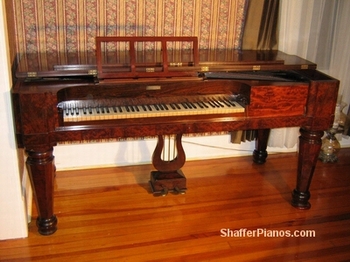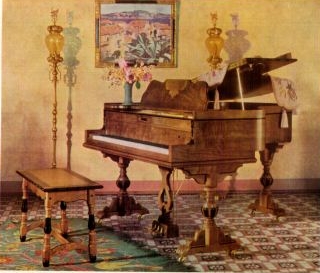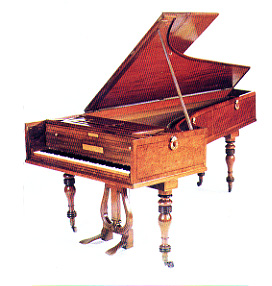

PIANOS IN THE HOME -- A Page for Interior Designers
At Shaffer Pianos, we find it rewarding to work with interior designers who are considering an antique piano to compliment fine decor or to serve as a focal point in a newly designed room. Very often, designers have a sense of which type of wood best works in the room as well as the preferred color. We carry a selection of pianos from the most prestigious makers in the world including Steinway, Bösendorfer, Erard, Pleyel and Chickering. These rare pianos have gorgeous veneers in mahogany, rosewood, or walnut.
Buying an antique piano from an antique dealer is a risky proposition. Often, antique dealers have very little knowledge concerning pianos and sometimes inadvertently sell an unrepairable antique piano to a collector. Shaffer Pianos ensures our pianos are sound before we purchase them. This provides the buyer with a much more desirable and valuable antique instrument following our thorough restoration.
In addition to the sale of antique pianos, we offer complete rebuilding, refinishing and other antique piano restoration services for your clients. When refinishing a piece of furniture, we can match a desired color using special tints and dyes similar in function to those used on pianos one hundred years ago. We can also finish any piano in ebony (satin or gloss) or any other color requested by the customer or designer. Many of the fine European pianos such as Bösendorfer Bechstein, Bluthner and Erard were available in ebony during the nineteenth century and look wonderful with such a finish.
Numerous options exist for the placement of pianos in rooms. Grand pianos can be placed against a wall or serve as a focal point in the middle of a room. While upright pianos were designed to be placed against a wall for purposes of saving space, they can also be used as an interesting focal point in the center of a room or as a divider in a large open space as pictured below. We can paint the back of antique uprights or cover them with a piece of antique material when requested to do so by a customer. We also have a selection of appropriate piano stools to accommodate any of our pianos and will reupholster the seats with your choice of fabric at no additional charge. |
 |
NINETEENTH CENTURY AMERICAN PIANOS
Federal Period Pianos
The Federal period came into existence after this nation's independence. Early Federal furniture witnessed the designs of Hepplewhite, Shearer, and Sheraton as the predominate furniture styles. Federal period furniture styles applied to pianos of this period as well. Colonists that could afford pianos, brought such instruments from England. Broadwood, and Longman and Broderip were among those piano makers.
Pianos were produced in limited numbers in Boston, Philadelphia, New York City and some other cities. Early American Federal Period pianos were small square grand pianos with slender legs, wooden frames, and often mahogany or cherry veneered. Around 1820, piano makers started producing pianos with turned and reeded legs, fancier moldings on the cases and flashier veneers like rosewood or crotch mahogany.
The piano on the left is an example of a fine Federal period instrument produced in America. While it may not appear to be much different from the square grand pictured below, the major difference is the latter incorporates cast iron into the frame for stability. The piano on the left is a lovely piece of federal furniture and if in sound condition when located and properly restored, can function as a beautiful period piano for many more years.
This style was phased out during the 1830s and replaced by the Empire style that emphasized richly figured mahogany and rosewood and pentagonal or octagonal tapered legs like the Nunns and Clark (1830) square piano featured below. Nunns and Clark was one of the early American piano makers that used the finest materials, building expensive, high quality instruments for more than fifty years. The piano below features scalloped ivory keytops, crotch mahogany and rosewood and a brass nameplate. It still retains the original finish in excellent condition for its age, showing evidence that it was well cared for. Our Nunns and Clark Square Piano was shown in a Metropolitan Home feature article (January 2009) on the work of Darryl Carter (scroll to the bottom of this page).
|
|
 |
Victorian Pianos -- The Mid 19th Century
The middle of the 19th century brought with it a revival of different furniture styles including Gothic, Rococo and Neoclassical. These elements of style could be found on some American pianos built in that century.
The tapered, octagonal legs can be found on most American square grand pianos and many grand pianos until about 1870. The 1863 Steinway square (below right) is an example of an American square piano prior to extreme carvings in case design that soon followed. The majority of American pianos built until 1870 were square grands. While the French, the English and Germans were producing more modestly priced uprights for homes, the Americans were making larger, heavier squares.
In the later 1800s, square grands increased in length, from an average of 6'5" during the 1830s to 1850s to about 7' in 1870. More notes were added, bringing them up to 85 notes, heavier wire was used, increasing the power, and the cases became more heavily carved, clearing the way for Victorian furniture to dominate the later nineteenth century in America. During the 1880s, American pianos makers started increasing upright piano production. It was around this time that it became more evident that the general consumer no longer desired the huge square pianos that had dominated the piano market for most f the nineteenth century.
In the 1860s and 1870s, some uprights were made in limited numbers. The Victorian upright piano shown at left is a very early upright by Steinway & Sons, built in 1868, just a few years after Steinway began producing uprights. Few uprights pianos from the 1860s are available for sale today.
The big three American piano makers in terms of quality and prestige were Chickering (America's oldest piano maker) Steinway and Knabe. All produced instruments of superb quality in a number of different case styles. While music racks varied little, and most possessed excellent rosewood or mahogany veneers, varieties of Victorian piano legs and case moldings drew distinctions. For the most part, American grand pianos by 1880 are modern pianos. They are overstrung, have a repetition action, and solid cast iron frames. When properly restored or rebuilt, they can function as well as a modern grand piano.
American Pianos from the Beginning of the Twentieth Century
By 1900, fancy Victorian pianos, like much of the American Victorian furniture was giving way to less ornate pianos. The legs were not heavily carved, the music racks did not display intricate fretwork. Rosewood was now much more expensive to obtain so mahogany became the predominant veneer of choice. A higher percentage of pianos were also being finished in ebony, often rubbed down to a satin finish. The Baldwin parlor grand piano below is an example of one of the finer pianos built shortly after the turn of the century.
A number of revivals can be seen in American furniture in the early twentieth century. An interest in Rococo style, Renaissance Revival furniture, as well as Queen Anne and King Louis furniture, influenced piano production during the time. Mahogany and walnut veneers (fewer in burled walnut) were used with simple-scrolled music racks. These pianos were often smaller (baby grand pianos) and a step down from their full-sized half-ton predecessors, but nonetheless served a purpose.
|
The 1920s was the heyday of piano manufacturing in the United States, with thousands of companies producing a variety of baby grands and upright or "vertical" pianos. Even though the average grand piano was much smaller than that of twenty years earlier, upright pianos were very large, some as tall as five feet. Sohmer, Knabe, Steinway, Chickering, Weber and Mcphail are just a few of the piano makers that produced fancy baby grand pianos during the 1920s and 1930s. While these pianos can still be located in most parts of the country, like any piano more than fifty years old, they often require restoration and in some cases, complete rebuilding. |
 |
NINETEENTH CENTURY FRENCH PIANOS
French piano making around 1800 was influenced by developments in England. By the 1820s, the French were setting their own standards in piano construction, design and innovation, due in large part to the innovations of Sebastian Erard. Paris was considered a city of great pride in culture, especially musical culture. The piano companies of Erard and Pleyel were held in very high regard in European concert halls and could only be afforded by the very wealthy. In fact, Erard boasted that their pianos were "the most expensive pianos in the world." Beethoven owned an Erard grand which he used for a number of years. Chopin and Liszt did much to add to the respect and prestige of Erards and Pleyels during the 19th century. The 1846 Pleyel (below right) is the same as that owned by Frederic Chopin.
French pianos were more costly to produce than American pianos for a number of reasons. Often, the fallboards contained the makers name in brass, inset into fine rosewood, mahogany or walnut veneer. An example is the fallboard of a rosewood Erard grand piano shown below, reading, "Patent Erard London" in polished brass. In contrast, American makers after 1840 often used decals (stickers) on their fallboards that could become damaged .
In addition to aesthetic differences such as the use of brass on the cases and larger, solid brass casters on the legs, the French continued to do all facets of piano construction by hand as late as 1900. Some forty years earlier, the Americans were depending largely on machines to carry out much of the construction.
During the Victorian period, American pianos started to produce heavily-carved, ornate pianos. The legs were massive, the case were sometimes scalloped, and the pedal lyres exhibited ornate designs as well. In contrast, the French found the American grand pianos to be showy, overdone, and unattractive. French pianos, Erard and Pleyel included, continued to use a case style that changed very little since the beginning of the nineteenth century. The legs were often cylindered-like, tapered from the top down to attractive brass casters. When they did display carvings, it still followed the lines of the legs. After 1870, the French pianos did display fret-work on their music desks similar to the American pianos, but continued to keep the amount of carved wood to a minimum on the cases.
|
In addition, they continued to produced straight-strung pianos until the twentieth century, allowing for what was a cleaner tone than the high-powered, over-strung American grands. This also allowed the French pianos to be built with a slimmer and often squared tail such as that in the Erard piano shown below. The advantage of French grand pianos in terms of working with other decor, is that their elegant, yet simple appearance is timeless. They work with Victorian furniture as well as modern decor. The French had been producing upright pianos for decades before the Americans. During the American Civil War, European piano companies like Pleyel and Erard were making excellent upright pianos for the household, while American companies such as Steinway, Chickering, Knabe and the hundreds of other piano companies, were concentrating on square grand piano production. In short, the top French pianos of the nineteenth century , when properly restored look beautiful, sound wonderful and make excellent choices for today's American homes. |
THE VIENNESE AND GERMAN PIANOS
Vienna was in many ways the musical center of Europe during the eighteenth and nineteenth centuries and that culture had a strong relationship with piano construction. Walter, Stein, Streicher, Graf and of course Bösendorfers were the prominent piano builders of the time. Mozart, Beethoven, Schubert, Mendelssohn, and Brahms were some of the great composers and pianists associated with Viennese pianos.
Classical pianists who have played on fine Viennese pianos have claimed that they now have a greater understanding for how some of the great works of Beethoven, Brahms and others should be played. The tone from Bösendorfers is unlike that of any American piano. It is warm, mellow and clear--free of any overtones or rumblings often associated with powerful, over-strung pianos of the 19th century. Most of Beethoven's early pianos were Viennese in make, having a light action that was used by some Viennese makers like Bösendorfer throughout the 19th century.
The Viennese, and to a lesser extent, German piano makers were more conservative than the Americans with many aspects of piano construction. They continued to produce straight-strung pianos up until late in the 19th century, nearly 40 years after Steinway decided to move to the over-strung piano we see today. It was believed by the Europeans that over-stringing (having the bass run over the top of the treble wire) creates a muffled sound. There may be some truth to that, as the fine Viennese pianos like Bösendorfer and Streicher do have a beautiful, clean tone. However, the Americans were concerned with increased power and wanted to fit the longest wire possible in a piano.
In addition to the reputation as building some of the finest pianos in the world, Vienna was also a leader in fine furniture production. In terms of appearance, Viennese and German pianos share more features with the other European piano makers in terms of simpler, tapered octagonal legs, brass fallboard nameplates and solid brass casters. They were not impressed by the highly carved ornate pianos the Americans were producing. The Viennese pianos often featured beautiful walnut cases with vertical grain or a polished ebony finish and a light bird's eye maple on the underside of the lid. The construction on many of the Viennese pianos and German pianos was simply superb, especially the large concert grands.
|
Bösendorfers were perhaps the most prestigious pianos in Austro-Hungarian Empire and still are today. They have a well-respected history dating back to 1828. Recently, Bösendorfer opened a showroom in New York City and has been wowing customers with their luxurious pianos. The Bosendorfer below is an example of one the finest pianos from the 1880s. While Vienna was widely considered to be the center of musical composition and piano construction during much of the 19th century, there were several German firms that were competing with the great houses of Bösendorfer and Streicher for the reputation as the finest piano maker. Bechstein and Bluthner were established around the same time as Steinway and produced pianos of very fine quality during the the 1800s. The German case style was generally very similar to the Viennese pianos such as the Bösendorfer at right, yet sometimes took a heavier look, including thicker legs. This style was well -constructed and allowed for an open, clear tone. The Viennese were very content with this design and utilized it from the Biedermeier period of the early 1800s, until the early 20th century.
|
ENGLISH ANTIQUE PIANOS
 |
Early British pianos were built not only for function, but as furniture to adorn the home as well. The British have some of the oldest piano makers in the world, with a long history of producing pianos not only for the middle class, but for Royalty as well. The Broadwood forte piano pictured at left is that owned by Beethoven during his later years. John Broadwood & Sons is the oldest and one of the most prestigious piano companies in the world. The instruments have been enjoyed by such famous people as Mozart, Haydn, Chopin, Beethoven and Liszt. The company holds the Royal Warrant as manufacturer of pianos to Queen Elizabeth II. Antique grand pianos of this era are very rare today as most have been destroyed, with the majority of those remaining, in museums. They were not constructed as well as those built after 1840, and are seldom used for playing. Broadwood, Collard and Kirkman are considered the three large old-established firms and built some fine grand and upright pianos during the 19th century. Smaller "cottage-uprights" were popular in the London area during the mid-1800s and some of the fine piano makers paid close attention to detail when constructing these cases. However, British piano production declined significantly after 1880 at around the time when American and German production was growing. |
Furniture constructed in Britain during the Victorian period utilized an overlapping of several styles from different eras -- namely, the Greek, the Gothic, Chippendale, and the Rococo. Furniture makers in London built some highly ornate pieces, including pianos that featured curved sides, highly carved panels featuring vines and flowers, and stunning book-matched burled walnut veneer. This circa 1850 cottage piano also features and Chippendale-style legs with highly carved knees and clawed feet.